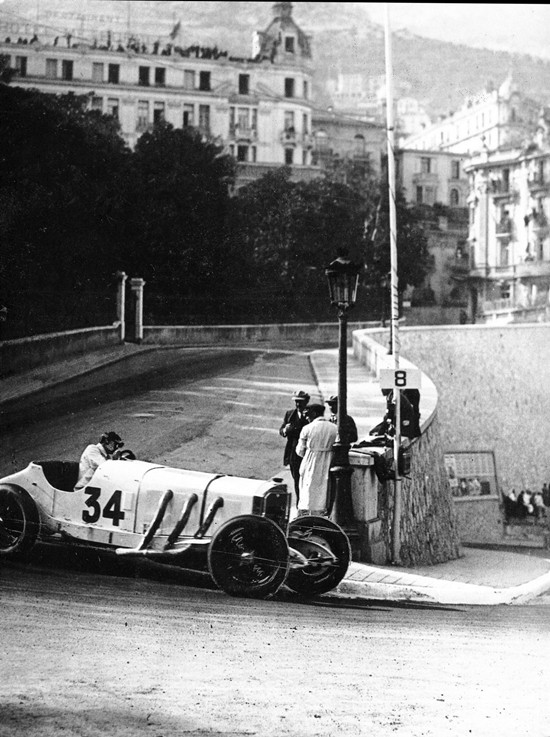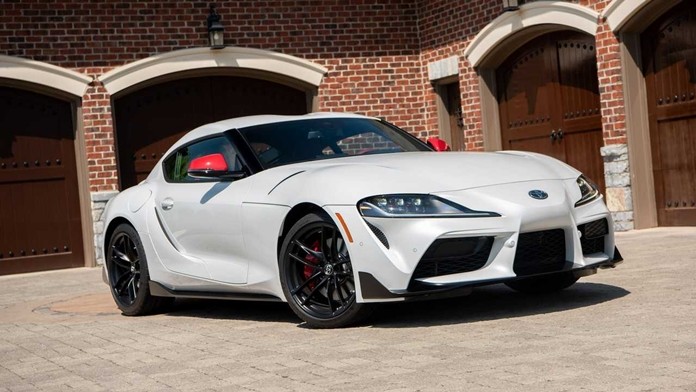
A harbor full of multi-million dollar yachts and car parks with supercars, starlets waiting to be discovered and retired soccer players and you have Monaco.
As a racing circuit, it is quite frankly a joke – far too narrow to pass another car, and the walls beckoning the drivers to try the concrete next time around.
First run in 1929, it has become an anachronism today. The 1996 event will be remembered for the reason only three cars finished!
The first race, held on 14 April 1929, was won by William Grover-Williams (using the pseudonym “Williams”), driving a works Bugatti Type 35B. It was an invitation-only event, but not all of those invited decided to attend. The leading Maserati and Alfa Romeo drivers decided not to compete, but Bugatti was well represented. Mercedes sent their leading driver, Rudolf Caracciola. Starting fifteenth, Caracciola drove a fighting race, taking his SSK into the lead before wasting 4½ minutes on refueling and a tyre change to finish second.
Another driver who competed using a pseudonym was “Georges Philippe”, the Baron Philippe de Rothschild. The Monegasque driver Chiron was unable to compete, having a prior commitment to compete in the Indianapolis 500 on the same day.

So to today. This will be the usual race of attrition and with passing hardly possible, a good qualifying is really important.
The race will start at 8 p.m. Thai time and we watch in Fletchers Folly, Siam Country Club Road, 300 meters before the Chicken intersection (Mitkamon) and opposite the Maxxis outlet.
The Chinese automotive world is in a slump
China’s auto sales sank 17.7 percent in April from a year earlier, the 10th straight month of decline amid trade tension with Washington and an economic slowdown.
Drivers in the industry’s biggest global market bought 1.6 million sedans, SUVs and minivans, according to an industry group, the China Association of Auto Manufacturers. Total vehicle sales, including trucks and buses, fell 14.6 percent to 2 million.
Jittery consumers are less willing to make big purchases amid a tariff war with Washington and unease about China’s economic outlook. Growth in the second-largest global economy held steady in the latest quarter but that was supported by government stimulus spending and higher bank lending.
The downturn is squeezing Chinese and global automakers that are pouring money into meeting government targets to develop electric vehicles.
Auto sales for the first four months of the year are off 14.7 percent from a year earlier at 6.8 million, according to CAAM.
Sales by Chinese brands in April plunged 27.9 percent from a year earlier to 585,000. Their market share contracted by 5.2 age points to 37.1 percent.
Purchases of electric and gasoline-electric hybrid SUVs and sedans rose 18.1 percent to 97,000. That was a bright spot for the industry but well below growth rates of as much as 100 percent in previous months.
Beijing has promoted electrics with billions of dollars in research grants and buyer subsidies. But subsidies are due to end next year and regulators are shifting the burden to automakers by imposing mandatory sales targets for electrics.
So automakers need to develop electrics that can compete with gasoline-powered vehicles.
Sales of SUVs fell 15.8 percent, CAAM said, without giving a total.
Last year’s auto sales suffered their first decline in nearly three decades, falling 4.1 percent from 2017 to 23.7 million.
The downturn has prompted suggestions Beijing will cut sales taxes or offer other incentives.
BMW and Toyota in bed together
In a manner very similar to Mazda and Fiat making their own Miata’s, Toyota 86 and Subaru BRZ, and now BMW’s Z4 and the new Toyota Supra have certainly cuddled up together.
In a joint development of over five years with BMW, the new Supra was finally released. Not a clone of each other as the manufacturers proclaimed, but what do you make of a sporty car that shares the same platform and engine? Electronics? A different calibration, and I remain unimpressed. Even switch gear!
Tetsuya Tada chief engineer for the new Supra and the Toyota 86 states both cars have completely different suspension and software calibration, for example. Practicality and comfort were almost not considered.
The 2020 Supra was tested by Car and Driver magazine (a publication that is generally truthful) and the 2020 Toyota Supra was very quick in a straight line. Toyota quotes a 4.1 second sprint to 60 miles per hour for the new Supra (and a limited top speed of 155 miles per hour), but a recent performance inspection proves the coupe could actually be quicker in a straight line.
In the Car and Driver test, the Supra hit 60 miles per hour in 3.8 seconds. Toyota is then 0.1 seconds quicker than the same engine inline six powered BMW Z4 on which it’s based (3.9 seconds). Though the two cars share the same turbocharged 3.0 liter inline-six engine, the Supra’s 335 horsepower (249 kilowatts) and 365 pound-feet (494 Newton-meters) of torque are 47 horses (35 kW) and four lb-ft down on the BMW Z4.

How can this be? Offsetting the claimed engine power, the Supra is lighter than the Z4, but not by much. The Supra weighs in at 1,540 kilograms, while the Supra is 1,561 kilograms. The Supra is more affordable, too. In the US, the Toyota starts at $49,990, where the inline-six-powered Z4 costs a hefty $65,690. How much of that 65,000 goes towards the nameplate? When you open the garage door, is your next door neighbor going to say “Wow! You’ve got a Toyota!” There, you’ve got the answer.
US agency scraps safety system proposal
Detroit (AP) — The U.S. government is withdrawing a proposal to require all passenger vehicles to have safety systems to prevent unintended acceleration.
The government said the rule isn’t needed because the auto industry has installed systems voluntarily.
The industry opposed the rule. It was proposed by the National Highway Traffic Safety Administration in 2012 after a series of unintended acceleration problems with Toyota vehicles.
The agency says all 2018 passenger vehicles have systems that override the throttle if a driver presses the gas and brakes at the same time, and it doesn’t expect any automakers to remove the brake-throttle override system in the future.
But Jason Levine, executive director of the nonprofit Center for Auto Safety, said it will take years to find out whether automakers installed the systems due to the threat of a regulation or could remove them without the regulation pending. “What we know today is that with no requirement, there is no performance standard for the throttle control system and nothing preventing it from being sold as a luxury feature,” he said. “We can only hope a few years from now we won’t see reports of crashes that could have been prevented by a required system that met minimum safety standards.”
The move comes as the administration of President Donald Trump pushes to reduce or eliminate regulations, which Trump considers an unnecessary burden on industry. “NHTSA does not find that there is presently a safety need for a BTO (brake-throttle override) requirement,” the agency said in the withdrawal notice, which was posted Monday on a government website.
The rule also would have required vehicles to return to idle if a driver stops pressing the gas pedal. But NHTSA wrote that it needs a broader understanding of safe design of vehicle electronic control systems to make a decision on that.
The proposed rule was an outgrowth of investigations in 2010 into claims that electronic defects were causing unintended acceleration in some Toyota models. An investigation by NHTSA and a separate study by NASA ruled out electronic defects in high-speed crashes and determined that in some cases drivers had inadvertently pressed the brake and gas pedal at the same time or that gas pedals had become trapped by floor mats.
One accident that gained attention was the August 2009 high-speed crash of a Lexus near San Diego that resulted in the deaths of four people. Investigators determined that the driver, a veteran California highway patrolman, had applied the brake of the loaned car but was unable to override the accelerator, which was trapped by a floor mat.
In February 2011, Toyota Motor Corp. recalled 2.17 million vehicles in the United States to address accelerator pedals that could become entrapped in floor mats or jammed in driver’s-side carpeting, prompting NHTSA to close its investigation. The agency also fined Toyota $50 million for not recalling millions of vehicles in a timely fashion.
The rule was aimed at minimizing the risk that drivers would lose control of their vehicles as a result of either accelerator-control system disconnections or accelerator-pedal sticking or floor-mat entrapment, the safety administration said at the time.
Autotrivia Quiz
Last week I asked: 22,000 orders on its first day of its release with only 101 BHP engine. What was this car? The answer was the Ford Mustang, one of the most popular new cars ever.
So to this week. How can you instantly differentiate between an MGA 1500, an MGA 1600, and an MGA 1600 Mk 2 and an MGA Twin Cam without measuring the capacity of the engine? There are four items. Any three will do.
For the Automania dehydrated beer this week (just add hops and water and store in a dark cupboard), be the first correct answer to email [email protected] or [email protected]. Good luck!
 |
 |
 |





